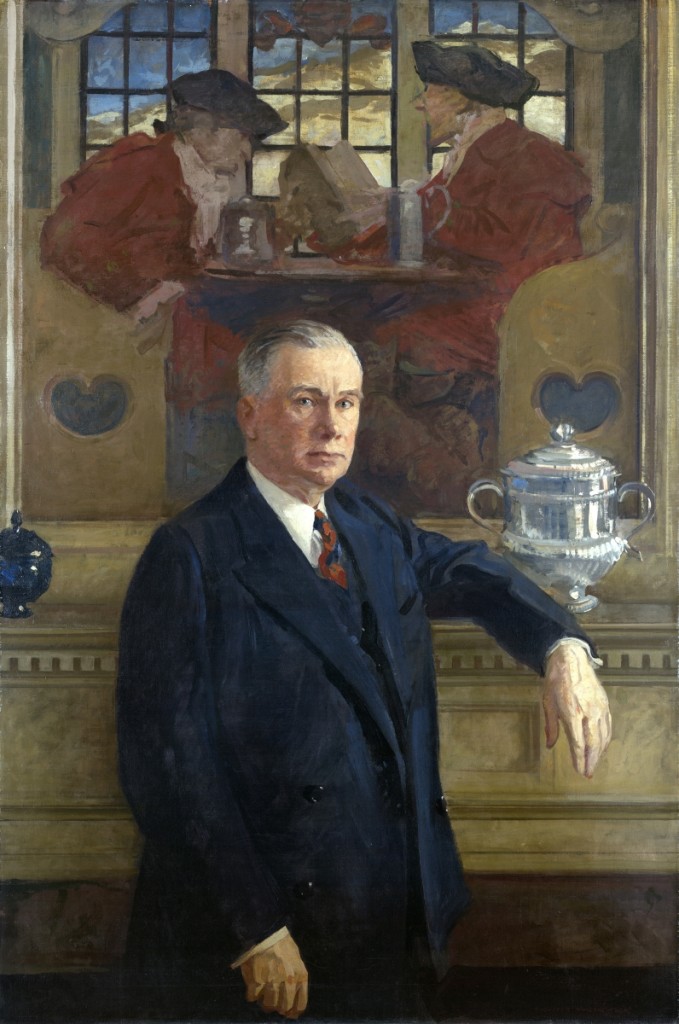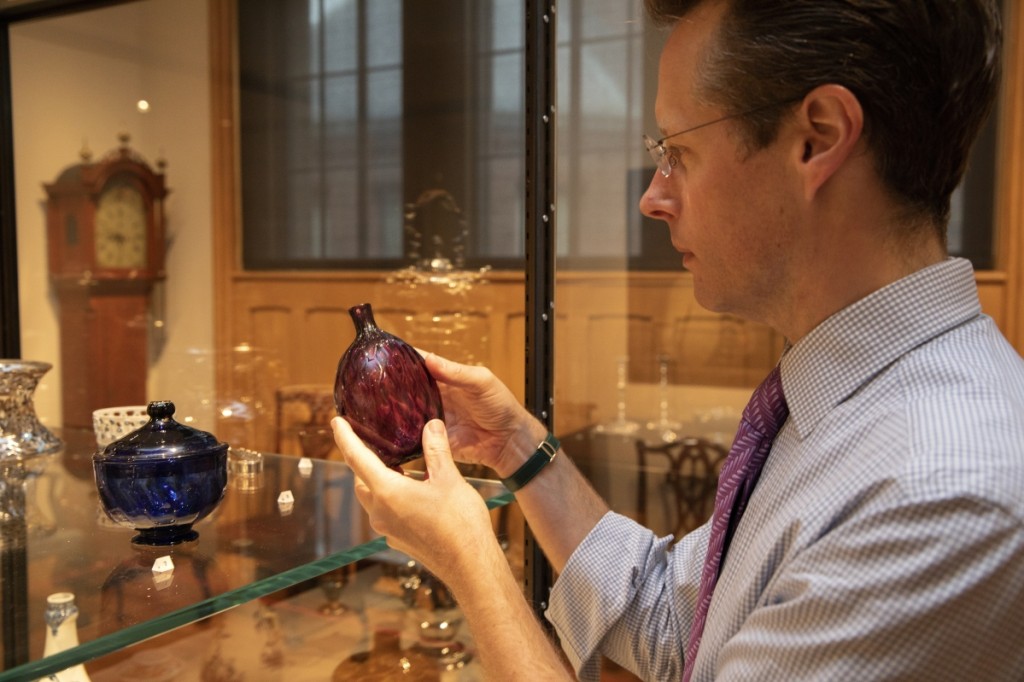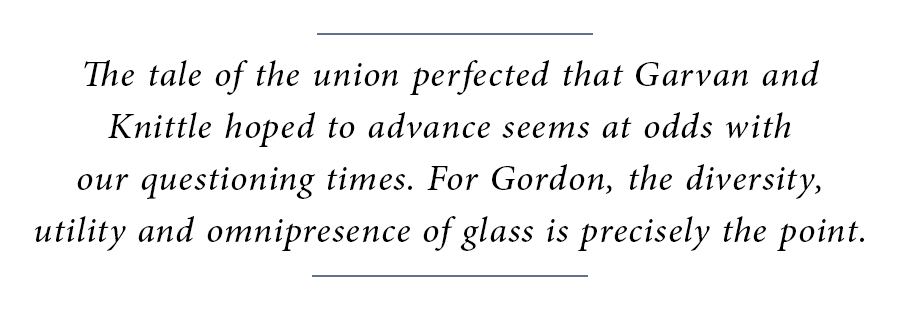By Laura Beach
NEW HAVEN, CONN. – “Dealers are the underappreciated element of the story. We tend to focus on makers and collectors,” John Stuart Gordon says, leading the way through the labyrinthine displays of the Yale University Art Gallery (YUAG), whose calm understatement and intimate scale stand in luxurious contrast to its formidable collections.
The Benjamin Attmore Hewitt Associate Curator of American Decorative Arts, Gordon arrived at YUAG in 2006 and is perhaps best known for his book A Modern World: American Design from the Yale University Art Gallery, 1920-1950 (Yale University Press, 2011). His affinity for contemporary design and fascination with craft have long been tempered by his tendency to look at all artistic phenomena through the lens of history. Past, present and future come together in Gordon’s imaginative new book, American Glass: The Collections at Yale, which evaluates attitudes toward the surprisingly ubiquitous medium in the years before and after Francis P. Garvan (1875-1937) began donating his collection, the nucleus for YUAG’s superlative holdings of American decorative art in 1930.
Behind every great collector, there is usually a dealer whose vision, expertise, tenacity and sheer nerve were decisive. Garvan, after a somewhat shaky start, availed himself of professional help. The least well-known among his advisors may have been Rhea Mansfield Knittle (1883-1955), the Midwestern dealer who earned Garvan’s lasting admiration after she published Early American Glass in 1927. Garvan never loved glass, Gordon says, at least not with the passion he reserved for silver, but through Knittle he came to understand its importance to the story of American virtue and enterprise that he and Knittle sought to tell through his collection.
If early American glass seems a fresh topic, it is because it has in recent years received scant attention outside specialist circles. Gordon and his YUAG colleagues sought to redress the oversight. Diane Wright – a Marcia Brady Tucker Fellow at Yale before becoming curator of glass at the Toledo Museum of Art – had begun researching Yale’s glass collection, winnowed by Meyric Rogers and others, then modestly enlarged by Charles Montgomery in the 1970s. Big names in the field – Helen McKearin, Kenneth M. Wilson, Dwight P. Lanmon and Arlene Palmer – were consulted, the latter advising Patricia E. Kane, Montgomery’s successor and the Friends of American Arts Curator of American Decorative Arts at YUAG. When Wright departed for Toledo, Gordon undertook a full survey of Yale’s glass collection in order to understand it. He had just finished A Modern World and was looking for “quick and easy” exhibitions to help fill YUAG’s expanded galleries. Quick and easy the glass project was not.
“Glass was not part of my education, nor part of most decorative arts educations. I found it daunting and exciting,” Gordon says. A visit to Yale in 2015 by glass dealer Ian Simmonds helped Gordon see the Garvan glass collection for the time capsule that it is. Formed between the 1910s and the 1930s, it embodies the biases and beliefs of an earlier generation of collectors.
Gordon observes shrewdly, “Vessels in the South Jersey tradition, with misshapen, heavy forms that early admirers felt echoed the rough-hewn furniture of the Pilgrim era, were in fact created in the second quarter of the Nineteenth Century. Bottles molded with portraits of the Founding Fathers were produced well into the Victorian period, and the numerous bowls and cup plates commemorating historical events were machine-made. Their age or means of production undercut the colonial authenticity that early collectors wanted them to embody.”
Drawing on unpublished correspondence between Garvan and Knittle, Gordon builds on research by Elizabeth Stillinger and Catherine L. Whalen to create a rich portrait of the collector and his dealer, “whose indefatigable zeal,” he writes, “transformed not only Garvan’s collection but also the field of American glass.” Along the way we meet other key personalities of the day, from Edwin Atlee Barber to George S. and Helen McKearin, Stiegel scholar Frederick William Hunter, John Branch Kerfoot and Louis Guerineau Myers, to name a few.
Rhea Mansfield was born in Ashland, Ohio, and in 1906 married Earl Joel Knittle, who shared her interest in early Ohio artifacts. A 1936 profile in the Cleveland Plain Dealer describes her as a slight, vivacious woman with sharp, birdlike motions and a love of colorful clothing. Her mother’s remarriage around 1898 to Henry V. Weil, a prominent 57th Street dealer in Manhattan, introduced Rhea to top collectors of American antiques. Among them was Francis P. Garvan, the Connecticut-born, Yale-educated lawyer and businessman who became a prominent collector of Americana after the death of his wealthy father-in-law, Anthony N. Brady, in 1913.
By 1917, Garvan had acquired Ohio-made ceramics and textiles from Knittle, whose growing interest and knowledge of glass culminated in her 1927 book, a work of meticulous research that moved beyond the familiar names of John Frederick Amelung and Henry William Stiegel. “It would remain the key scholarly text until the publication of Helen and George S. McKearin’s American Glass in 1941,” the curator notes.
The Garvan-Knittle partnership was both playful and combative. Gordon, who studied troves of letters at Yale and at the Smithsonian’s Archives of American Art, says, “They obviously liked each other. He is much more verbose in his letters to her than to others. She often mentions other collectors she’s worked with, articles or books she’s recently read and thinks Garvan should read too. She is always trying to assert herself as a scholar, to prove herself in a way a male dealer would not have had to. The misogyny of the field at that time comes through in other letters between male authors and male recipients, like when Rhea is referred to as the ‘glass lady.’ You get a sense that she is racing against something.”
That something was the Depression. In late 1929, Knittle asked for $3,000 to catalog, pack and ship the McKearin glass collection, offered to Garvan intact for $400,000. Garvan replied indignantly, “You are now asking more than the judges of the Supreme Court of the United States and the traffic won’t bear it.” Initially taken aback, Knittle tried to salvage the deal early in 1930, but Garvan’s financial circumstances had worsened. He curtailed much of his buying and began transferring his collections to Yale. Knittle’s catalog of Yale’s glass collection remained unfinished when he died in 1937.

“Garvan clearly understood the importance of glass in his collection,” says Gordon, noting Garvan’s decision to have the blue sugar bowl painted into his portrait. “Francis P. Garvan” by Augustus Vincent Tack, circa 1930. Oil on canvas. Bequest of Mabel Brady Garvan.
Garvan never warmed to pressed glass, though through Knittle’s efforts he came to own some choice pieces attributed to the Boston and Sandwich Glass Works. These early to mid-Nineteenth Century objects form a delicate bridge to the later glass in Yale’s collection, which takes on an altogether different character post-Garvan. Charles Montgomery, who became the Garvan curator in 1970, sought to bring Yale’s collection up to date by acquiring exemplary late Nineteenth and early Twentieth Century pieces. It has been the mission of Kane and Gordon, for a time working with Wright, to bring Yale’s selective holdings up to the present. Through their efforts Yale now has a small but strong core of studio glass from the second half of the Twentieth Century.
A tour of Yale’s third-floor galleries devoted to Modern and Contemporary art and design yields surprises. Harvey Littleton’s iceberg-like “exploded” vase of 1965, a 2009 acquisition, echoes work done around the same time by makers such as Peter Voulkos, a clay artist, and George Nakashima, whose medium was wood.
“Spring Grass II,” a 1983 creation by Toots Zynsky, more resembles carefully coifed AstroTurf than a basin fabricated of ultra-fine strands of extruded glass. After bidding unsuccessfully at auction on a similar piece by Zynsky, Yale’s curators acquired this boundary-pushing specimen of quasi-utilitarian art directly from the artist in 2010.
Tom Patti’s 1978 “Clear Air-Frame with Pinstripes,” added to the collection in 2009, speaks obliquely to humankind’s role in the degradation of the planet. Under high heat, airborne pollutants coating the glass shards Patti used to make the small sculpture became gossamer plumes of grey.
“This is a relatively recent acquisition,” Gordon says of “Path of Destruction,” a 1964 enamel on copper triptych by enamellist Margarete Seeler and metalworker Frances Felten. “I wanted to include contemporary makers who really play with what glass can do. Seeler helped pioneer this atmospheric use of enamel. You get the sense that she is painting with glass. And she is thinking about medieval and Renaissance art, but reinterpreting the iconography,” the curator observes.
The book ends provocatively with an essay on the politics of glass, accompanied by an illustration of “Cotton Field,” the stained glass window shattered by a Yale College employee incensed by the window’s romanticized view of slavery in the Antebellum South. The glass, manufactured by D’Ascenzo Studios in Philadelphia in 1932, was incorporated into the architecture of the dining hall at Yale’s Calhoun College, named for the seventh vice president of the United States, a staunch supporter of slavery.
“As a curator, whose job it is to care for cultural objects and the stories they contain, I could never condone the willful destruction of a work of art. But I recognize how the interpretation of art evolves,” Gordon writes. The same might be said of Yale’s glass collection. The tale of the union perfected that Garvan and Knittle hoped to advance seems at odds with our questioning times. For Gordon, the diversity, utility and omnipresence of glass is precisely the point.
Gordon is currently teaching a course on American glass to a small group of Yale undergraduates. Class efforts will be folded into an exhibit opening at Yale University Art Gallery on March 29.
American Glass: The Collections at Yale is published by Yale University Art Gallery in association with Yale University Press. For details, go to yalebooks.yale.edu.
Yale University Art Gallery is at 1111 Chapel Street. For more information, www.artgallery.yale.edu or 203-432-0600.





















